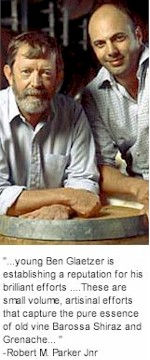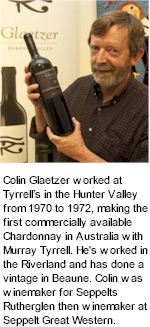


The first Glaetzers settled in the Barossa Valley in 1888 after emigrating from Brandenburg, Germany. The family left Germany on board the Nord-Deutscher Lloyd steamer Habsburg and took seven weeks to reach their final destination of Port Adelaide. From here they settled in a country town called Nuriootpa in the Barossa Valley where they started their new life in Australia. The family were some of the earliest recorded viticulturalists in the Barossa Valley and Clare Valley and the current generation is firmly entrenched in the family wine business.

After completing his degree at Roseworthy in 1970, Colin Glaetzer worked at Tyrrell’s in the Hunter Valley from 1970 to 1972, making the first commercially available Chardonnay in Australia with Murray Tyrrell. From there Colin moved to the Riverland before travelling to Bristol to work at Avery’s prior to a vintage for Remoissenet in Beaune. He returned to Australia to commence as winemaker for Seppelts Rutherglen winery then became chief white winemaker at Seppelts Great Western.
In 1985 Colin moved to the Barossa Valley to run Barossa Valley Estate, where he created the now revered E&E Black Pepper Shiraz and the Ebenezer range of wines. In 1995 Colin and Judith Glaetzer and their three sons established Glaetzer Wines allowing the production of boutique super premium wines under a family owned label. The Winery is located in the heart of the Barossa Valley at Tanunda.
It is the pinnacle of Colin's 30-year career with achievements such as his creation of the revered Barossa Valley Estates E & E Black Pepper Shiraz. The birth of Glaetzer Wines also signalled a new era for Colin's family which boasts more than its fair share of winemakers. The clan includes Colin, his oenology-trained wife Judith, twin brother/winemaker John, and five winemakers among the couple's three sons and their wives.

Colin and his winemaker son Ben have a shared philosophy. Both firmly believe that great wines are made in the vineyard. Their belief in good terroir and an understanding of the ancient dry-grown vineyards in the renowned Ebenezer district of the Barossa is evident. Exceptional fruit from a loyal group of third and fourth generation Barossa grape growers is the backbone of Glaetzer wines.
The Barossa Valley is one of the most famous regions of South Australia. With an abundant history dating back to 1847 and a distinctive and profound - Silesian influence, it is asserting its importance, and the immeasurable value of its storehouse of century old vines and historic wineries. Glaetzer's fruit comes from the famed Ebenezer vineyard in the north west of the Barossa Valley. The old vines of Ebenezer are an important part of Australia's winemaking heritage and a living link to traditional Barossa viticulture. The exceptional fruit used in the flagship Glaetzer Amon-ra Shiraz and Glaetzer Shiraz is sourced from 80-110 year old, non-grafted bush vines which are exceptionally low yielding. Most of the vineyards are non-irrigated but some of the newer vines (propagated from original plantings) have supplementary drip irrigation to combat stress in drought years. With minimal intervention, Colin and Ben make the unique, elegant wines which are regarded as classics and unmistakably Barossa Valley.
The climate and soils of the Barossa Valley vary markedly from north to south. The warmer Ebenezer district has low rainfall and relative humidity which results in full, intensely-coloured wines. The softness, elegance and approachability of Ebenezer fruit has become the hallmark of the Glaetzer house style. The very old vines require minimal attention. Their deep root structure means they are self-sufficient and can adapt to climatic extremes. Ebenezer has a unique soil profile. The well-drained sandy clay loam over a solid limestone pan is perfect for growing Shiraz. The soil is 'mean' and encourages deep roots which helps produce hugely concentrated wines of great character.
